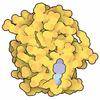Entry Database : PDB / ID : 5uanTitle Crystal structure of multi-domain RAR-beta-RXR-alpha heterodimer on DNA (Retinoic acid receptor ...) x 2 DNA (5'-D(*CP*TP*AP*GP*GP*TP*CP*AP*AP*AP*GP*GP*TP*CP*AP*GP*C)-3')DNA (5'-D(*GP*CP*TP*GP*AP*CP*CP*TP*TP*TP*GP*AP*CP*CP*TP*AP*G)-3')Nuclear receptor coactivator 2 Keywords / / / / Function / homology Function Domain/homology Component
/ / / / / / / / / / / / / / / / / / / / / / / / / / / / / / / / / / / / / / / / / / / / / / / / / / / / / / / / / / / / / / / / / / / / / / / / / / / / / / / / / / / / / / / / / / / / / / / / / / / / / / / / / / / / / / / / / / / / / / / / / / / / / / / / / / / / / / / / / / / / / / / / / / / / / / / / / / / / / / / / / / / / / / / / / / / / / / / / / Biological species Homo sapiens (human)Method / / / / Resolution : 3.508 Å Authors Chandra, V. / Wu, D. / Kim, Y. / Rastinejad, F. Journal : Nat Commun / Year : 2017Title : The quaternary architecture of RAR beta-RXR alpha heterodimer facilitates domain-domain signal transmission.Authors : Chandra, V. / Wu, D. / Li, S. / Potluri, N. / Kim, Y. / Rastinejad, F. History Deposition Dec 19, 2016 Deposition site / Processing site Revision 1.0 Oct 18, 2017 Provider / Type Revision 1.1 Apr 18, 2018 Group / Database references / Category Item _citation.journal_volume / _citation.page_first ... _citation.journal_volume / _citation.page_first / _citation.page_last / _citation.pdbx_database_id_PubMed / _citation.title Revision 1.2 Oct 4, 2023 Group / Database references / Refinement descriptionCategory chem_comp_atom / chem_comp_bond ... chem_comp_atom / chem_comp_bond / database_2 / pdbx_initial_refinement_model Item / _database_2.pdbx_database_accession
Show all Show less
 Yorodumi
Yorodumi Open data
Open data Basic information
Basic information Components
Components Keywords
Keywords Function and homology information
Function and homology information Homo sapiens (human)
Homo sapiens (human) X-RAY DIFFRACTION /
X-RAY DIFFRACTION /  SYNCHROTRON /
SYNCHROTRON /  MOLECULAR REPLACEMENT /
MOLECULAR REPLACEMENT /  molecular replacement / Resolution: 3.508 Å
molecular replacement / Resolution: 3.508 Å  Authors
Authors Citation
Citation Journal: Nat Commun / Year: 2017
Journal: Nat Commun / Year: 2017 Structure visualization
Structure visualization Molmil
Molmil Jmol/JSmol
Jmol/JSmol Downloads & links
Downloads & links Download
Download 5uan.cif.gz
5uan.cif.gz PDBx/mmCIF format
PDBx/mmCIF format pdb5uan.ent.gz
pdb5uan.ent.gz PDB format
PDB format 5uan.json.gz
5uan.json.gz PDBx/mmJSON format
PDBx/mmJSON format Other downloads
Other downloads 5uan_validation.pdf.gz
5uan_validation.pdf.gz wwPDB validaton report
wwPDB validaton report 5uan_full_validation.pdf.gz
5uan_full_validation.pdf.gz 5uan_validation.xml.gz
5uan_validation.xml.gz 5uan_validation.cif.gz
5uan_validation.cif.gz https://data.pdbj.org/pub/pdb/validation_reports/ua/5uan
https://data.pdbj.org/pub/pdb/validation_reports/ua/5uan ftp://data.pdbj.org/pub/pdb/validation_reports/ua/5uan
ftp://data.pdbj.org/pub/pdb/validation_reports/ua/5uan Links
Links Assembly
Assembly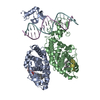
 Components
Components Homo sapiens (human) / Gene: RXRA, NR2B1 / Production host:
Homo sapiens (human) / Gene: RXRA, NR2B1 / Production host: 
 Homo sapiens (human) / Gene: RARB, HAP, NR1B2 / Production host:
Homo sapiens (human) / Gene: RARB, HAP, NR1B2 / Production host: 
 Homo sapiens (human) / References: UniProt: E7EWM1, UniProt: Q15596*PLUS
Homo sapiens (human) / References: UniProt: E7EWM1, UniProt: Q15596*PLUS Homo sapiens (human)
Homo sapiens (human) Homo sapiens (human)
Homo sapiens (human)

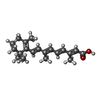


 X-RAY DIFFRACTION / Number of used crystals: 1
X-RAY DIFFRACTION / Number of used crystals: 1  Sample preparation
Sample preparation SYNCHROTRON / Site:
SYNCHROTRON / Site:  APS
APS  / Beamline: 19-ID / Wavelength: 0.979 Å
/ Beamline: 19-ID / Wavelength: 0.979 Å molecular replacement
molecular replacement Processing
Processing MOLECULAR REPLACEMENT
MOLECULAR REPLACEMENT Movie
Movie Controller
Controller




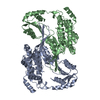

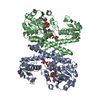


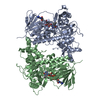
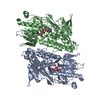

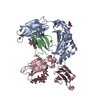

 PDBj
PDBj






































